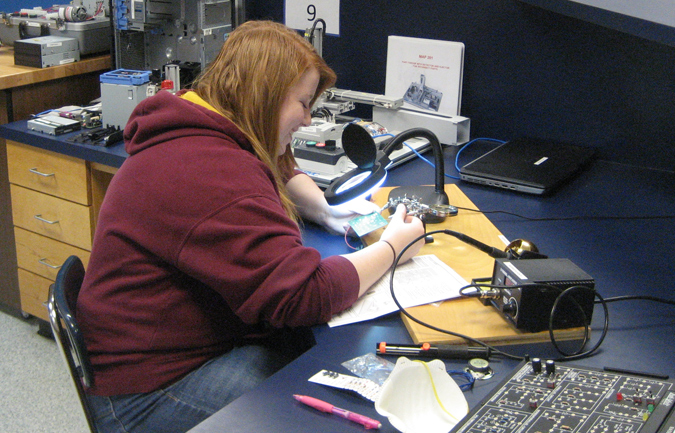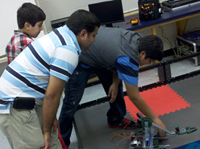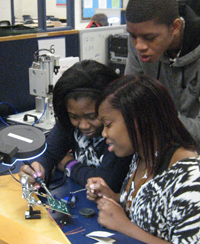Seizing Prosperity through Unemployable Youth
Print This Post
BY REBECCA RICE
Georgia has the third-lowest rate of employment among young people ages 16-24 in the nation. This dismal ranking has dire consequences for both the young people who are out of jobs, and the future of Georgia’s workforce, since failure to gain skills and experience now can lead to chronic underemployment later in life. An unskilled workforce also makes Georgia less attractive to industry and new business, which threatens our hope for a prosperous future. The good news is that at least one Georgia technical college has developed a dual degree program that’s producing staggering employment statistics.
At Moultrie Technical College (MTC), a school in Southwest Georgia with 2,500 students, the dual degree program with local high schools boasts more than 500 enrolled students and a historic job placement rate above 90 percent.
“Some of our programs targeted people who were basically unemployable,” said Dr. Shawn Utley, vice president for Economic Development at MTC. “They had no diploma or GED, and many had been incarcerated. We believe—in a nutshell—that everyone is employable. Everybody has some use somewhere in the workforce, and it’s up to us to provide them with the resources to help them become employable.”
Opportunities Within Reach
 |
Perhaps most impressive about the expansion of the dual degree program is how much it relied on existing resources at the technical college and local high schools. For their new course in mechatronics, which teaches advanced trades such as hydraulics, pneumatics, and robotics, MTC was able to use space at a partner high school and provide their own faculty. In essence, they created a leading edge technical program with state-of-the-art facilities using the resources already available in a small town in Southwest Georgia.
In addition to building on existing infrastructure, program coordinators focused on making facilities and classes accessible to the dual enrollment high-school students.
“The dual enrollment program has to be run in a way that is most convenient and advantageous to the student,” said Utley. “We have a campus in Tift County that is right next door to the high school. We teach at the high school so those students won’t have to commute 25 minutes each way.”
Making the program both efficient and accessible has helped with fundraising as well. According to Utley, securing grants has been easy because of the program’s ability to demonstrate both clear need and strong results. This success has caused both industry and other states to take notice. Alabama has contacted MTC about implementing similar programs there.
“We spent a month in Alabama, setting them up with the same programs we have here, so yes, this program is very replicable,” said Utley. “And other states are willing to pay for it.”
Reconnecting with Disconnected Youth
 |
Georgia is competing with other states for new industry, and having a skilled workforce is key to attracting jobs. Disconnected youth represent a huge potential labor pool—but only if they’re equipped with the tools and resources necessary to learn and to make employment connections. As other states begin to replicate the programs that link disconnected youth with skills and employers, it’s imperative that Georgia continues to build on these programs and innovate.
“Georgia needs to invest in all aspects of manufacturing, including education and training and business start-ups,” said Utley. “The unemployment in our region increases or decreases based on manufacturing jobs. There is no doubt that Georgia can bring in more jobs if we offer a skilled workforce. You can look at tax incentives and recruitment, but the main reason new business is going to come to your community is because you have an available workforce.”
Today’s disconnected youth are potentially Georgia’s solution for the future if we can learn from programs like Moultrie Technical College’s dual degree structure. While the lingering recession is a factor, the larger issue is a multi-generational cycle of poverty. For disconnected youth, poverty, low-performing schools, and an absence of working adult role models present significant obstacles to education and employment. Programs like those at MTC offer the resources and connections to break that cycle, which has a positive impact on the entire region.
“We pay for unemployed and disconnected youth one way or another,” said Utley. “You can pick your intervention—K-12, technical college system, the corrections system, whatever—but the bottom line is that you have to decide how you want to pay and what you want the results to be. Ultimately, these kids can join the workforce and begin career cycles that their families and communities have never experienced.”
Rebecca Rice is the Georgia KIDS COUNT coordinator at Georgia Family Connection Partnership.
Resources
More than 200,000 Georgia teens and young adults are not in school and not working. They are failing to gain the skills employers require in the 21st century. According to a new KIDS COUNT report from the Annie E. Casey Foundation, this lack of training and experience is likely to send young people veering down a path to chronic underemployment as adults. Read “Employment Among Young People at Lowest Since WWII.”
Read Youth and Work: Restoring Teen and Young Adult Connections to Opportunity. The report includes the latest youth employment data for every state, the District of Columbia and the nation.
Information on disconnected youth and young adults is available in the KIDS COUNT Data Center.
